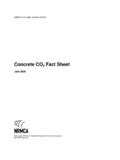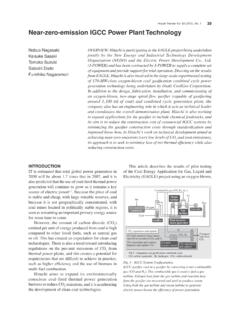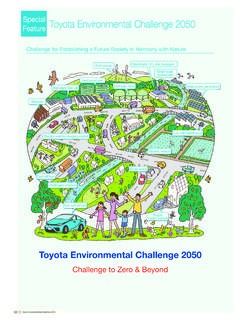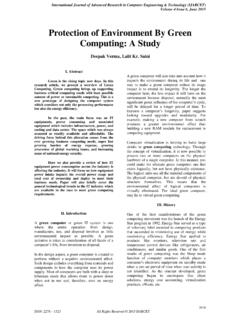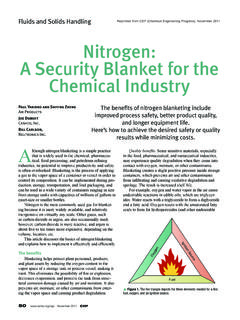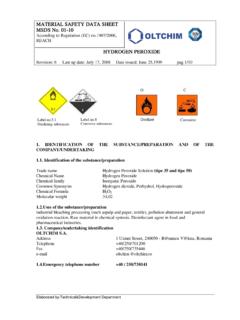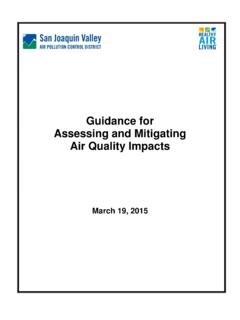Transcription of Standard Guide for Ultra-Pure Water Used in the ...
1 Designation: D 5127 07 Standard Guide forUltra-Pure Water Used in the Electronics andSemiconductor Industries1 This Standard is issued under the fixed designation D 5127; the number immediately following the designation indicates the year oforiginal adoption or, in the case of revision, the year of last revision. A number in parentheses indicates the year of last reapproval. Asuperscript epsilon (e) indicates an editorial change since the last revision or This Guide provides recommendations for Water qualityrelated to electronics and semiconductor-industry manufactur-ing. Six classifications of Water are described, including waterfor line widths as low as micron. In all cases, therecommendations are for Water at the point of distribution(POD). Water is used for washing and rinsing of semiconductorcomponents during manufacture.
2 Water is also used for clean-ing and etching operations, making steam for oxidation ofsilicon surfaces, preparing photomasks, and depositing lumi-nescent materials. Other applications are in the developmentand fabrication of solid-state devices, thin-film devices, com-munication lasers, light-emitting diodes, photo-detectors,printed circuits, memory devices, vacuum-tube devices, orelectrolytic Users needing Water qualities different from those de-scribed here should consult other Water standards, such asSpecificationD 1193and GuideD Standard does not purport to address all of thesafety concerns, if any, associated with its use. It is theresponsibility of the user of this Standard to establish appro-priate safety and health practices and determine the applica-bility of regulatory limitations prior to Referenced Standards.
3 2D 1129 Terminology Relating to WaterD 1193 Specification for Reagent WaterD 1976 Test Method for Elements in Water by Inductively-Coupled Argon Plasma Atomic Emission SpectroscopyD 2791 Test Method for On-line Determination of Sodiumin WaterD 3919 Practice for Measuring Trace Elements in Water byGraphite Furnace Atomic Absorption SpectrophotometryD 4191 Test Method for Sodium in Water by AtomicAbsorption SpectrophotometryD 4192 Test Method for Potassium in Water by AtomicAbsorption SpectrophotometryD 4327 Test Method for Anions in Water by ChemicallySuppressed Ion ChromatographyD 4453 Practice for Handling of Ultra-Pure Water SamplesD 4517 Test Method for Low-Level Total Silica in High-Purity Water by Flameless Atomic Absorption Spectros-copyD 5173 Test Method for On-Line Monitoring of CarbonCompounds in Water by Chemical Oxidation, by UV LightOxidation, by Both.
4 Or by High Temperature CombustionFollowed by Gas Phase NDIR or by Electrolytic Conduc-tivityD 5196 Guide for Bio-Applications Grade WaterD 5391 Test Method for Electrical Conductivity and Resis-tivity of a Flowing High Purity Water SampleD 5462 Test Method for On-Line Measurement of Low-Level Dissolved Oxygen in WaterD 5542 Test Methods for Trace Anions in High Purity Waterby Ion ChromatographyD 5544 Test Method for On-Line Measurement of ResidueAfter Evaporation of High-Purity WaterD 5673 Test Method for Elements in Water by InductivelyCoupled Plasma Mass SpectrometryD 5996 Test Method for Measuring Anionic Contaminantsin High-Purity Water by On-Line Ion ChromatographyD 5997 Test Method for On-Line Monitoring of Total Car-bon, Inorganic Carbon in Water by Ultraviolet, PersulfateOxidation, and Membrane Conductivity DetectionF 1094 Test Methods for Microbiological Monitoring ofWater Used for Processing Electron and MicroelectronicDevices by Direct Pressure Tap Sampling Valve and by thePresterilized Plastic Bag Method3.
5 For definitions of terms used in this guiderefer to TerminologyD of Terms Specific to This Standard :1 This Guide is under the jurisdiction of ASTM Committee D19 on Water and isthe direct responsibility of Subcommittee on General Specifications,Technical Resources, and Statistical edition approved April 15, 2007. Published May 2007. Originallyapproved in 1990. Last previous edition approved in 1999 as D 5127 referenced ASTM standards, visit the ASTM website, , orcontact ASTM Customer Service at ForAnnual Book of ASTMS tandardsvolume information, refer to the Standard s Document Summary page onthe ASTM ASTM International, 100 Barr Harbor Drive, PO Box C700, West Conshohocken, PA 19428-2959, United bacterial counts,n total number of cultureablemicroorganisms present in the named sample, excluding obli-gate anaerobic organisms, determined in accordance with TestMethodsF organic carbon (TOC),n carbon measuredafter inorganic-carbon response has been eliminated by one ofthe prescribed ASTM test Significance and This Guide recommends the Water quality required forthe electronics and microelectronics industries.
6 High-puritywater is required to prevent contamination of products duringmanufacture, since contamination can lead to an unacceptable,low yield of electronic The range of Water purity is defined in accordance withthe manufacturing process. The types of Ultra-Pure Water aredefined with respect to device line width. In all cases, thewater-quality recommendations apply at the point of The limits on the impurities are related to currentcontamination specifications and to available analytical meth-ods (either performed in a suitable clean laboratory or byon-line instrumentation). On-line and off-line methods are usedin accordance with current industry practice. Concentration ofthe sample may be required to measure the impurities at thelevels indicated inTable Six types of electronic-grade Water are described in thisguide.
7 In all cases, the Water -quality recommendations apply atthe point of E-1 This Water is classified as microelectronicwater to be used in the production of devices having linewidths between and This Water is classified as microelec-tronic Water to be used in the production of devices having linewidths between and 1 Requirements for Water at the Point of Distribution in the Electronics and Semiconductor IndustriesAParameterType E-1 Type E-2 Type E-3 Type E-4 Linewidth (microns) > Resistivity, 25 C (On-line) ( g/L) (on-line for <10 ppb)521503001000On-line dissolved oxygen ( g/L)25103 On-Line Residue after evaporation ( g/L) On-line particles/L (micron range) <100 <100<10 <50<5 <100<20<1 SEM particles/L (micron range) <250 <1003000 110050<30 10 000 10<50<30<10 100 000 Bacteria in CFU/Volume100 mL Sample53110501001 L Sample10 Silica total ( g/L)53110501000 Silica dissolved ( g/L) Anions and Ammonium by IC ( g/L) by ICP/MS ( g/L) user should be advised that analytical data often are instrument dependent and technique dependent.
8 Thus, the numbers inTable 1are only is monitored only as an operational parameter for monitoring the ion-exchange This Water is classified as microelec-tronic Water to be used in the production of devices having linewidths between and m. It is the Water of ultimatepractical purity produced in large volumes, and is intended forthe most critical E-2 This Water is classified as microelectronicwater to be used in the production of devices that havedimensions between 1 and 5 E-3 This grade of Water is classified as macro-electronic Water to be used in the production of devices havingdimensions larger than 5 m. This grade may be used toproduce larger components and some small components notaffected by trace amounts of E-4 This grade may be classified as Water usedin preparation of plating solutions and for other applicationswhere the Water being used can be of lesser Components of the Water system for producingelectronic-grade Water shall be grouped into five generalprocess sections for the purpose of simplifying the organizationof the components of the systems.
9 These processes are de-scribed The processes in this category includethe addition of various types of coagulants, precipitatingagents, clarifiers, sedimentation tanks, and particulate-filtrationsystems (including sand filters, disposable filter elements,ultrafilter membranes, and other particle-removing systems).Adsorbent or entrapment beds may include greensand, acti-vated carbon, and various synthetic materials specific forcertain organic and inorganic This process is fundamental to theproduction of Ultra-Pure Water of all grades, and may includemore than one of the processes of ion exchange, reverseosmosis, electrodialysis, continuous electrodeionization, or allof the above. The size of the system governs the choice of thecombination of desalination processes. Various configurationsof the different processes should be considered, includingtwo-bed and mixed-bed demineralization, multi-stage reverseosmosis employing various types of membranes, electrodeion-ization, and and Biological Removal Systems Removalof biological and organic contaminants is an important adjunctto any system used to prepare Ultra-Pure Water .
10 Dissolvedorganic compounds can accumulate in the system during theprocess as well as being present in the original Water . Methodsof minimizing biological contamination include the addition ofhydrogen peroxide and ozone. Ultraviolet irradiation at the 185nm wavelength provides intense energy for breaking chemicalbonds and produces traces of ozone. The 185 nm light lysesbacteria and breaks down organic compounds to organic acidsand carbon dioxide. With the destruction of organics, TOC willbe reduced. Therefore, 185 nm light should only be usedupstream of the final ion-exchange component. Ultravioletirradiation at 254 nm significantly reduces the growth oforganisms by dislocating the DNA base pairs. This processprevents the bacteria from replicating. Membrane filters (in-cluding reverse osmosis and ultrafilters) may also removebiological impurities as well as organic molecules.
